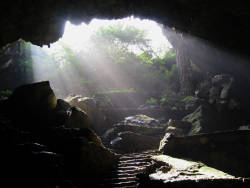張公洞地下河探險
Zhanggong Cave Underground Stream Adventure - 张公洞 - Zhanggong Dong
Useful Information
| Location: |
China, Jiangsu, Wuxi, Yixing, 206县道 邮政编码: 214223.
Yufeng Hill, 22 km southwest of Yixing. (31.253503, 119.780219) |
| Open: |
MAR to NOV daily 7:30-17. DE to FEB daily 8-16:30. [2023] |
| Fee: |
Adults CNY 79. [2023] |
| Classification: |
 Karst Cave Karst Cave
|
| Light: |
 Incandescent Incandescent
 Coloured Light Coloured Light
|
| Dimension: | Ar=3,000 m², L=1,000 m, St=1,500. |
| Guided tours: | D=2 h. V=20,000/a [2006] V=500,000/a [2011] |
| Photography: | allowed |
| Accessibility: | no |
| Bibliography: | |
| Address: | Zhanggong Dong, Zhangyang Village, Hufu Town, Yixing City, Wuxi City, Tel: +86-510-87478808, Tel: +86-510-87478801, Tel: +86-510-87478805. |
| As far as we know this information was accurate when it was published (see years in brackets), but may have changed since then. Please check rates and details directly with the companies in question if you need more recent info. |
|
History
| 1919 | cave developed by Chu Nanqiang. |
| 11-NOV-1934 | cave opened to the public. |
| 2006 | leased by the Yixing Pacific Jinlong Water Equipment Co., Ltd. and transformed into a "scenic spot". |
| 2009 | theme park opened. |
Description



张公洞 (Zhanggong Dong, Zhanggong Cave) is named after Zhang Guolao, an old Taoist hermit who once lived here. The cave visit is rather strenuous, as it includes an ascent of 1,500 steps from the lowest cave to the top of the hill. There is a Taoist temple with great views and well worth the ascent. And of course "countless small caves inside a big cave", whatever that means. The cave is also known as 庚桑洞 (Gengsang Cave) and as Taoist Zhang Cave.
According to legend, a hermit named Gengsang chose to live in seclusion in the Yufeng Mountain during Spring and Autumn. During the Han Dynasty, Zhang Daoling, a famous Taoist, went on a spiritual journey in the cave. During the Tang Dynasty, Zhang Guolao, another revered Taoist immortal, took refuge in the cave. As a result of its significant role in Taoist history, the cave became known as Zhanggong Dong, the cave which makes Zhangs (Taoist title).
The show cave has a long history, there are reports of visits from the Middle Ages. After all, there was a Taoist temple on the top of the hill, and many visitors to the temple also visited the cave. Unfortunately, it’s tricky to separate actual reports from religious legends. At that time it must have been a semi-wild cave with dirt tracks and no light. In the jiwei year of the Hongzhi era (1499), Shen Zhou travelled to Yixing and toured the area with his friend Wu Lun. They took a boat trip to Zhanggong Dong and passed Yanhua Xi (Yanhua stream) en route. Shen Zhou documented the trip on paper scroll with a painting of the river and a poem. In its heyday, the cave earned titles such as “The Most Extraordinary Cave in Southern China” and “The Premier Taoist Sanctuary in East China”. In Taoism, there are 36 caves of heavenly abodes and 72 blessed lands where immortals reside and roam. Zhanggong Cave is thought to be the fifty-eighth blessed land. Inside are several Taoist structures like the Liangyi Pavilion, Hui Xian Bridge, and the Gateway Arch. At the cave entrance is the Dongling Temple, which houses eight halls adorned with thirty-six statues of deities.
The cave was developed as a show cave by a local businessman in 1919. Chu Nanqinang was a pioneer of tourism in Yixing. We don’t know why the cave wasn’t opened to the public until 1934, 15 years later. Probably the political situation delayed the process. Then the cave was operated almost unchanged for more than 70 years.
Like numerous others, the site was transformed into a modern Chinese "scenic area", which seems to be a euphemism for theme park. It is now called 張公洞地下河探險 (Zhanggong Cave Underground Stream Adventure). While the cave was visited by 20,000 visitors per year, the theme park is now visited by half a million. We are not sure how much the cave was changed, but even Chinese visitors find the excessive colours of the cave annoying and call it "really tacky neon lighting displays".
The new scenic area still offers the cave tour, which seems, except for the light, to be more or less the same. They also added the Underground Stream Adventure, which is a 500 m long river passage which is visited by boat. Visitors actually have to row the boats themselves, and there is an additional fee fore this "fun adventure". The whitewater adventure seems to be a 1,500 m long artificial water slide.
- See also
 Search DuckDuckGo for "Zhanggong Dong"
Search DuckDuckGo for "Zhanggong Dong" Google Earth Placemark
Google Earth Placemark OpenStreetMap
OpenStreetMap Zhanggong Cave, official website (visited: 03-JUN-2021)
Zhanggong Cave, official website (visited: 03-JUN-2021) Zhanggong Cave, Yixing – Ticket Price, Opening Hours, Transportation, And Highlights (visited: 09-DEC-2023)
Zhanggong Cave, Yixing – Ticket Price, Opening Hours, Transportation, And Highlights (visited: 09-DEC-2023) Outing to Zhang Gong’s Grotto (visited: 10-DEC-2023)
Outing to Zhang Gong’s Grotto (visited: 10-DEC-2023)
 Index
Index Topics
Topics Hierarchical
Hierarchical Countries
Countries Maps
Maps